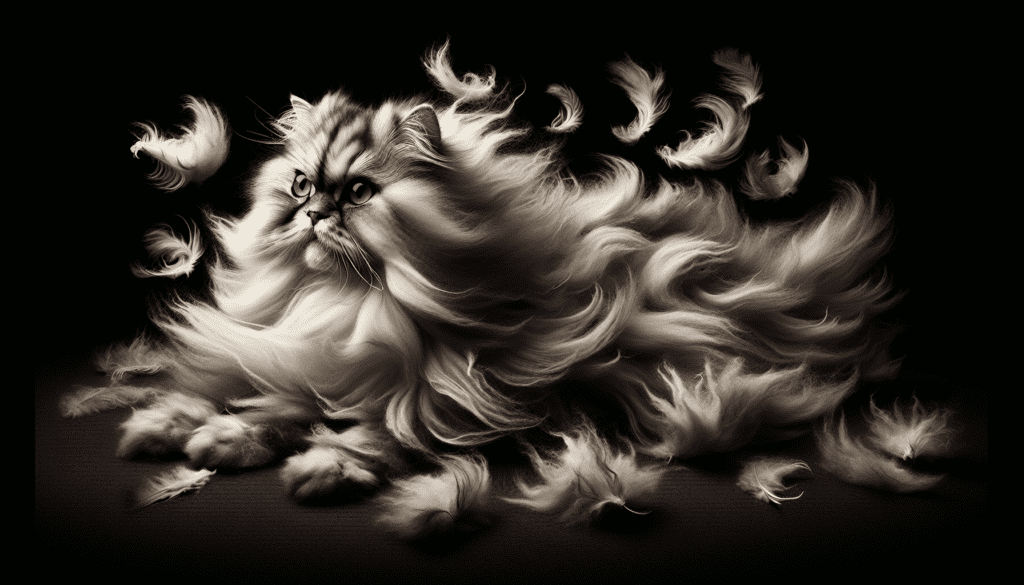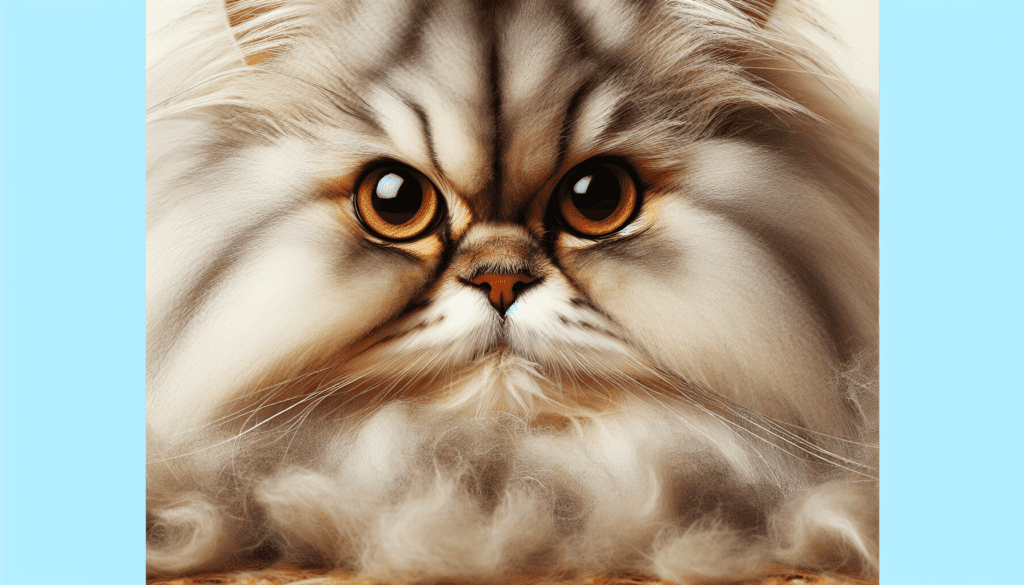Persian cats are known for their stunning beauty: fluffy coats, expressive eyes, and a regal charm that captivates all those who lay eyes on them. But, one question that often arises in the minds of potential Persian cat owners is: do they shed? In this article, we will explore the shedding habits of Persian cats and provide you with all the information you need to know about keeping your home fur-free while enjoying the company of these majestic feline companions. So, if you’ve ever wondered about the shedding tendencies of Persian cats, keep reading to uncover the truth.
Overview of Persian Cats
Description
Persian cats are known for their luxurious and long coats, expressive round faces, and strikingly beautiful appearance. Their thick fur, combined with their short legs and stocky bodies, gives them a regal and majestic presence. Persian cats have a wide range of coat colors and patterns, including solid colors, tabby patterns, and bi-colors. Their eyes are typically large and round, adding to their overall charm and allure.
History
The history of Persian cats can be traced back to ancient Persia, now present-day Iran. These feline companions were highly valued and treasured by the nobility and royalty of the Persian Empire. It is believed that Persian cats were initially brought to Europe in the 17th century, where they quickly gained popularity among cat lovers. Over time, selective breeding focused on enhancing their distinct features, such as their luxurious coats and unique facial structure, resulting in the Persian cats we know and love today.
Temperament
Persian cats are known for their gentle and calm nature, making them excellent companions for those seeking a peaceful and serene pet. They often enjoy a relaxed and laid-back lifestyle, preferring cozy spots to curl up and nap. Persian cats are generally friendly and loving, forming strong bonds with their owners. They tend to be affectionate and enjoy being pampered with gentle petting and grooming. Despite their calm demeanor, Persian cats still possess a playful side and can engage in lighthearted games, especially with interactive toys.
Understanding Shedding in Persian Cats
What is Cat Shedding?
Shedding is a natural process in which cats lose old or damaged fur to allow the growth of new fur. It is essential for maintaining their coat health and temperature regulation. During shedding, cats release fur from both the outer guard hairs and the softer undercoat. The amount of shedding can vary among different cat breeds and individual cats. Understanding the shedding process is crucial for cat owners, especially those with Persian cats, as their long, dense fur can result in more pronounced shedding.
Factors Affecting Shedding in Cats
Various factors can influence the shedding patterns of cats. One of the most significant factors is the cat’s breed. Some breeds, like Persian cats, naturally have more abundant and longer fur, which leads to more shedding. Additionally, a cat’s health, age, and diet can affect the condition of their coat and the intensity of shedding. Environmental factors, such as changes in temperature and exposure to artificial heating or cooling, can also impact shedding frequency.
Specifics of Shedding in Persian Cats
Persian cats have a unique shedding pattern due to their luxurious and abundant coats. While all cats shed, Persian cats tend to shed continuously throughout the year. Their long, dense fur can easily become entangled and form mats, which can lead to more noticeable shedding if not properly managed. Regular grooming is essential to prevent matting and excessive shedding in Persian cats. Understanding their specific shedding behaviors and implementing appropriate grooming techniques can help keep their coat healthy and minimize shedding concerns.


Frequency of Shedding in Persian Cats
Normal Shedding Patterns
As mentioned previously, Persian cats have a constant shedding pattern. Unlike other cat breeds that may experience more significant shedding during specific seasons, Persian cats shed consistently throughout the year. This means that cat owners should be prepared for regular maintenance to keep their Persian’s coat in top condition and minimize shedding around the house.
Seasonal Shedding
While Persian cats do not exhibit the same seasonal shedding patterns as some other breeds, they may experience slight variations in shedding during temperature changes. The transition between seasons, particularly from warmer to cooler weather, can trigger a slightly increased shedding period. However, this shedding is still less pronounced compared to cat breeds that significantly shed during spring and fall.
Signs of Excessive Shedding
While shedding is a natural occurrence, excessive shedding in Persian cats can be a cause for concern. If you notice an excessive amount of loose fur or noticeable thinning of your Persian cat’s coat, it may indicate an underlying issue. This could be due to improper nutrition, stress, hormonal imbalance, or skin conditions. If you suspect excessive shedding, it’s vital to consult with a veterinarian to rule out any potential health problems and develop a suitable management plan.
Managing Shedding in Persian Cats
Regular Grooming
To manage shedding effectively in Persian cats, regular grooming is crucial. Brushing your Persian cat’s coat at least two to three times a week helps prevent mats and tangles, reducing the amount of loose fur around the house. Grooming sessions also provide an opportunity to bond with your feline companion and keep their coat in optimal condition. Regular grooming removes loose hair and distributes natural oils, promoting a healthy and glossy coat.
Brushing Techniques
When grooming a Persian cat, it is essential to use the right brushing techniques. Start by using a wide-toothed comb or a slicker brush to gently remove tangles and mats. Take your time and be patient, as Persian cats may have sensitive skin and delicate coat. Follow up with a fine-toothed comb to remove any remaining loose hair. Consider using grooming tools specifically designed for long-haired cats to effectively manage shedding and maintain the beauty of their coat.
Bathing Routines
Regular bathing can also help manage shedding in Persian cats. Bathing not only keeps their coat clean but also reduces the amount of loose fur by washing away dead hair. Use a mild cat shampoo specifically formulated for long-haired breeds. Take care to thoroughly rinse out all shampoo residue to prevent skin irritation. It is important to note that excessive bathing can strip essential oils from their coat, so consult with your veterinarian for guidance on an appropriate bathing schedule for your Persian cat.
Hairball Prevention
Persian cats are prone to developing hairballs due to their long fur and grooming habits. Hairballs can be uncomfortable for your cat and lead to digestive issues. To help prevent hairballs, incorporate hairball prevention supplements or treats into their diet. Additionally, make sure your Persian cat has access to fresh drinking water to stay adequately hydrated, which aids in the passage of hair through the digestive system. Regular brushing and grooming also reduce the amount of hair ingested during self-grooming.


Dealing with Allergies and Shedding
Causes of Allergic Reactions
Allergies to cats are commonly caused by a protein called Fel d 1, which is found in cat saliva, urine, and dander (dead skin cells). Persian cats, like other cat breeds, produce this allergenic protein. However, due to their long and dense fur, some people may find that they have a milder allergic reaction to Persian cats compared to short-haired breeds. It’s important to note that no cat breed is completely hypoallergenic, and individual sensitivities to allergens can vary.
Reducing Allergens in the House
If you or someone in your household has allergies to Persian cats, there are measures you can take to reduce allergens in the house. Regular grooming and brushing help remove loose hair and dander, minimizing airborne allergens. Frequent vacuuming, using a vacuum cleaner with a HEPA filter, and regularly washing bedding can also help reduce allergen levels. Consider designating certain areas of the house as “cat-free zones” to provide allergy sufferers with a space where they can retreat without exposure to allergens.
Health Concerns Related to Shedding
Skin Problems
The long and dense coat of Persian cats requires diligent care to prevent skin problems. If shedding is not properly managed, it can lead to matting and tangled fur, which can irritate their skin and cause discomfort. Skin issues, such as dermatitis, hot spots, and fungal infections, can arise if the skin is not kept clean and dry. Regular grooming, including brushing and bathing, helps maintain a healthy coat and minimizes the risk of skin problems.
Respiratory Issues
Excessive shedding and the presence of loose fur in the environment can contribute to respiratory issues for both cats and humans. Loose fur can be inhaled and cause irritation to the respiratory tract, particularly for individuals with pre-existing respiratory conditions like asthma. By effectively managing shedding through regular grooming and maintaining a clean living environment, the risk of respiratory issues can be minimized for both Persian cats and their owners.
Frequently Asked Questions about Shedding in Persian Cats
Are Persian Cats Hypoallergenic?
While some people with allergies may find Persian cats more tolerable due to their long fur trapping some allergens, Persian cats are not considered hypoallergenic. Allergies are highly individual, and it’s essential to spend time with a Persian cat before bringing one into your home if you or someone in your household has allergies.
Do All Persian Cats Shed Equally?
While all Persian cats shed to some extent, the amount of shedding can vary among individuals. Factors such as genetics, coat quality, grooming routines, and overall health can influence shedding patterns. Some Persian cats may shed more lightly, while others may have a more substantial shedding presence. Regular grooming and proper care can help manage shedding for all Persian cats.
What is the Best Way to Control Shedding?
The best way to control shedding in Persian cats is through a comprehensive grooming routine. Regularly brushing their coat, using appropriate grooming tools, and bathing as needed help remove loose hair, prevent matting, and maintain a healthy coat. Additionally, providing a clean living environment through regular vacuuming and minimizing potential irritants can also help control shedding. Consulting with a veterinarian for personalized advice based on your Persian cat’s specific needs is always recommended.
In conclusion, shedding is a natural process for Persian cats, and understanding its specifics and proper management techniques is crucial for cat owners. By implementing regular grooming routines, maintaining a clean living environment, and addressing any underlying health concerns, shedding in Persian cats can be effectively managed. With proper care and attention, you can enjoy the regal beauty of your Persian cat while keeping shedding concerns to a minimum.

